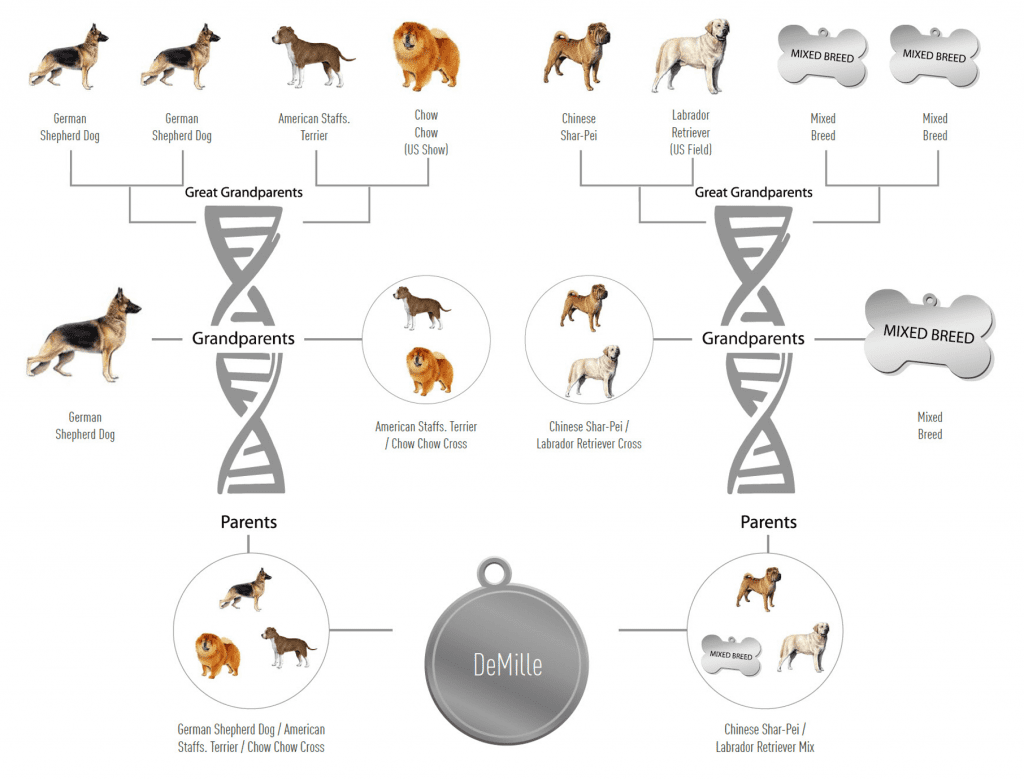Click to learn more about author Bree Baich.
Remember the conundrum Goldilocks had while trying to find the ideal mattress? Papa Bear’s was too hard, Mama’s was too soft, but when she stretched out on Baby Bear’s bed, the feeling was sublime. Finding that perfect mix of data and story can feel like that. If you add too much data, the audience is overwhelmed, too little and they’re questioning results. Stories need a healthy balance of data and narrative to make an audience feel comfortable. I’ve found the best way to explain this harmony is through real-life examples. Like a story about DNA results.
By now you’re probably aware that for less than $100 and a mouth swab you can track ancestral lineage. But did you know companies like Royal Canin offer the same for a dog?
In a broad sense, canine DNA testing – administered through a veterinarian – determines genealogy along with specific genetic markers. When I adopted a Hurricane Harvey Rescue, I decided to test her DNA to uncover predisposed conditions based on her breed.
A simple blood test and four weeks later the results were in.
Image credit: Royal Canin Genetic Health Analysis, DeMille
She’s not an Australian Cattle Dog as the shelter had categorized her. Instead, DeMille is ¼ German Shepard tracing back generations. The rest is most likely a blend of breeds that fit her DNA marker pattern; American Staffordshire Terrier, Shar-Pei, Chow and Labrador. Except for one of her parents whose data was so complex for three generations they classified it as “mixed breed” – there was no way to conclusively determine what the remaining genetics were comprised of.
Though mixed breed still leaves a gap in her lineage, Royal Canin’s findings prove what her temperament already told me; DeMille comes from an active, loyal, protective heritage. In this case, uncovering additional details tied to her parental gap wouldn’t influence my delightful adopter experience thus far.
The report also included breed characteristics and genetic health indicators used to “predict the possibility of certain health conditions.” Both of which are necessary for me to understand what the future looks like as DeMille’s adopter. It infused the right amount of information to create a roadmap the vet and I will use moving forward.
To find a perfect mix of data and story think analytically as you process the data at hand.
- Purge Unnecessary Data
Too much data is overwhelming. Purge non-supportive results.
DeMille’s report included details such as breed characteristics and a checklist of traits typically found within each breed. Those data points (along with my optic analysis) reveal her physical blueprint as having a Shepard’s snout, a Labrador’s tail, and when you squish her face in just the right way to give her some love, it’s all Shar-Pei.
Something the document didn’t offer was life expectancy – by breed. While that might be intriguing, her 6-plus breed mix makes it irrelevant to the overall roadmap we’re creating. What is important is how her mix works together long term.
Stacking the deck with great details doesn’t work in compelling data stories. Helping the audience overcome obstacles lays the groundwork for faster decision making.
- Be Proactive
There’s always an end goal with data storytelling – getting an audience to act on results. Proactively including data one needs to act, is essential.
The lab tests for 140 genetic health indicators and the MDR1 genetic mutation, which tells me their screening is thorough. However, the document only called out the mutation typically found in mixed breed dogs since it “…may have side effects or adverse reactions…” to certain medications.
Including breed characteristics is important to paint a larger picture; adding her predictive data is vital for creating a wellness plan.
The ability to stay focused on the end goal exemplifies great storytellers.
- Include Opportunities for Self-Discovery
Give people an avenue to learn more, as needed.
In DeMille’s analysis summary, Royal Canin highlighted their comprehensive journey to her result – examining over 3000 markers and sorting through information for over 250 breeds. Rather than delivering extensive findings to me, they inserted a call to action, “If you have not already consulted with your veterinarian, be sure to schedule an appointment to find out more information.”
It’s likely some audience members will require a deeper understanding. Give them opportunities for self-discovery though interactive dashboards, knowledge bases, or open lines of communication.
Now, it may seem as though data was the only ingredient – of the perfect mix – I highlighted here. That was the point. Stories should feel natural as they set the tone for how well an audience connects with data. In this example, DNA results shared through the lens of a canine adopter took a complex, clinical topic and made it relatable. For an audience to feel serene, like Baby Bear’s mattress, there needs to be a healthy balance of story and data.


